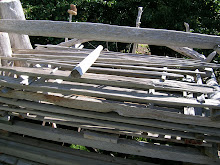
While driving across country this spring I initially stopped at every, and then when that was too frequent, every other rest stop. Somewhere in Minnesota stopping put me on the shore of a lake in the Mississippi river where muscles grew prolifically. It became the center of the shell button industry, which subsequently vanished when the shells were over-harvested and buttons could be made of other materials. Do these old buttons have something to do with that experience?
I found an old red World War II ration token in the bunch of buttons, and a scissor sharpener, and an old hem stripper.
Two summers ago driving across the country and wanting to make a souvenir of my trip, I stopped in Zanesville, Ohio. Outside of town I met a guy selling tokens of lots of things, including UPA blue and red ration tokens like this one I found in the button tin. I hadn’t seen them before and had asked what they were. I bought a few other things with local significance. Now another one of these tokens appears in a mess of buttons. Would I have known what it was or taken the time to find out? Why does that matter? I don’t know yet. It has an evocative power that informs a stubborn attachment to matter.
 The truth is that I still don’t know what the button collection is about: the old buttons with their threads still attached and their discoloration and their shades of off-white. Someone over time buttoned those buttons into buttonholes. And unbuttoned them and lived and played and laughed and cried, and most of them came from shells and maybe one of them came from a lake formed in the Mississippi river in Minnesota, part of an industry that formed and developed and disappeared. A trace remains on a sign in a rest stop parking lot. I like knowing about this
The truth is that I still don’t know what the button collection is about: the old buttons with their threads still attached and their discoloration and their shades of off-white. Someone over time buttoned those buttons into buttonholes. And unbuttoned them and lived and played and laughed and cried, and most of them came from shells and maybe one of them came from a lake formed in the Mississippi river in Minnesota, part of an industry that formed and developed and disappeared. A trace remains on a sign in a rest stop parking lot. I like knowing about thisI am drawn to write this text on a surface; perhaps, the interior of a container of buttons.

No comments:
Post a Comment